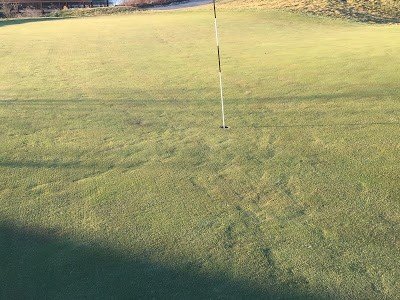Building a Better Green: Victoria National on a mission to discover ideal seed and soil mix
Upgrading clubhouses and building new cottages enhances the stay-and-play experience, but truly great golf comes down to greens maintenance. Over the past year, the Victoria National agronomy team has been troubleshooting and testing potential solutions concerning the now 21-year-old L-93 bentgrass greens.
Getting to the root of the problem.
When it became clear the network needed help troubleshooting, several external agronomists visited the course to test and measure health of the greens. They found an iron oxide layer between the mix and gravel layers, which is affecting proper water movement into the drainage lines. Recent heavy rainfall is sitting stagnant in the root zone, where it actually boils in the hot southern Indiana summer sun, causing severe damage to root and turf health.
To counter these affects, Dormie Network has invested in an Air2G2 machine to relieve compaction, increase porosity, and force gas exchange. A second process brought on a custom deep-drill machine that allows deep drill aerification to 15 inches, removing areas of the iron oxide layer to create drainage channels. With increased drainage, the agronomy team may be able to avoid drastic measures, such as rebuilding the greens.
While troubleshooting the issue, Victoria National has spearheaded a new tactic that may change how the network plans and executes its cultural practices: a test plot nursery green.
Building a test environment.
Last fall, the 30-foot by 50-foot green was constructed to full USGA specifications, including two linear and seven lateral drainage lines, followed by six inches of gravel, and topped with 12 inches of mix. Five main seed varieties (L-93XD, A1-A4, 007, Pure Distinction, and T-1) and four different mixes (with varying levels of sand and soil designed to test moisture levels, root depth, and turf quality) were paired and separated into plots measuring eight feet by seven-and-a-half feet. To prevent cross-contamination, the team installed a plastic vapor barrier. Once seeded, pre-plant fertilizer was applied and raked in two directions followed by dimpling of the seed with Sand Pro tires.
In addition to the five seed varieties listed above (some of the current top varieties used in bentgrass greens across the country), six newer varieties were planted at the far end of the plot for testing.
Throughout the 2019 growing season, the team has maintained the new test green alongside active course greens, on the same mowing, fertilization, watering, and cultural practice schedule. Each plot in each growing medium is tested for volumetric moisture and root depth. When the plots have grown in completely and have a consistent smooth surface, the team will begin to compare speeds among the turf varieties, as well as turf quality and playability for greens construction, to make recommendations for courses across the network in upcoming years.














